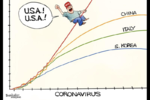I'm not trying to crap on the data or the analysis or anything, it just seems so incredibly complex, I think it is difficult to draw assumptions from it. For instance, in addition to what I already noted, could it have something to do with where the largest percentages of jobs that people have that can't be done from home are? How does the fact that in some places it is much less common to leave your house, neighborhood, for anything other than work and the store affect the comparitive nature of the data? It almost seems impossible to me to take that data and be sure of anything.
Does the fact that I live in one of the few counties in my state where it does seem like it has changed drastically make me feel better, sure. But, we also have the most cases, and we've hardly done any tests, so I'm not sure that comfort is warranted.



